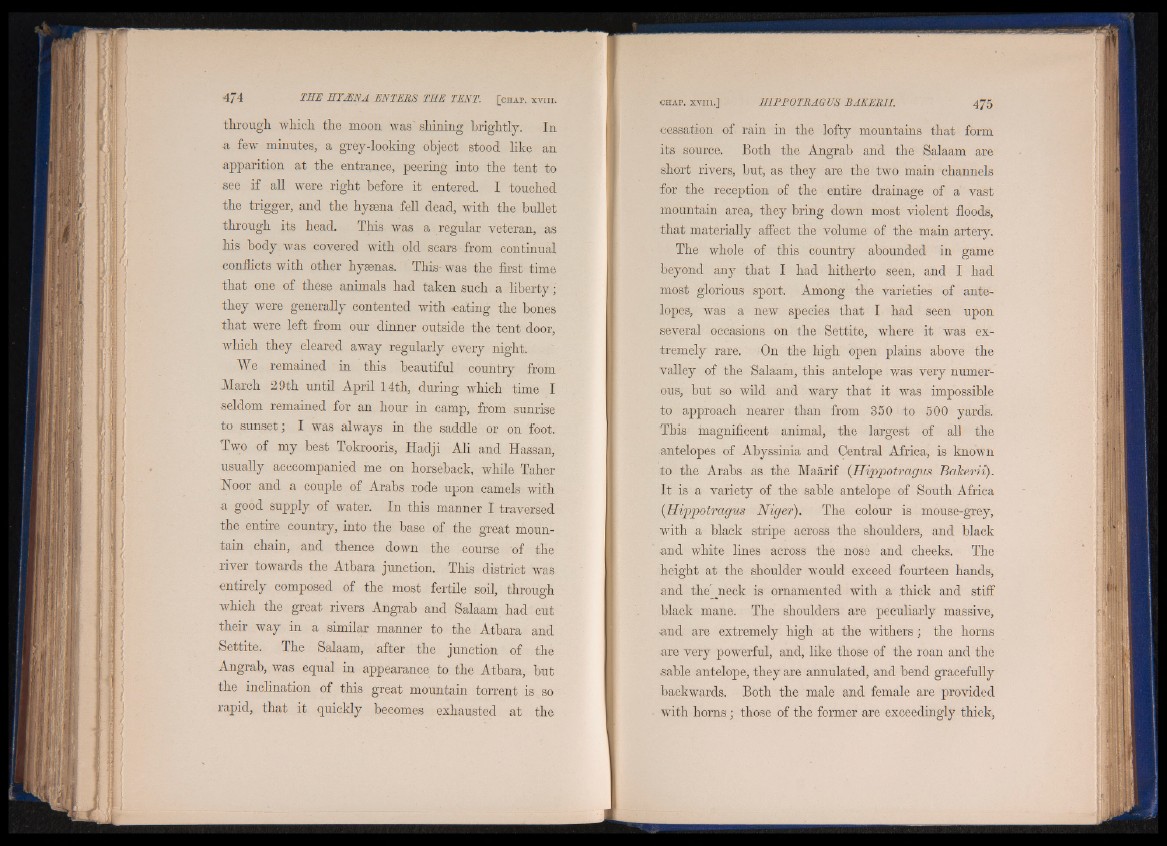
through which the moon was'shining brightly. In
a few minutes, a grey-looking object stood like an
apparition at the entrance, peering into the tent to
see if all were right before it entered. I touched
the trigger, and the hysena fell dead, with the bullet
through its head. This was a regular veteran, as
his body was covered with old scars from continual
conflicts with other hysenas. This- was the first time
that one of these animals had taken such a liberty•
they were generally contented with .eating the bones
that were left from our dinner outside the tent door,
•which they cleared away regularly every night.
We remained in this beautiful country from
March 29th until April 14th, during which time I
seldom remained for an hour in camp, from sunrise
to sunset j I was always in the saddle or on foot.
Two of my best Tokrooris, Hadji Ali and Hassan,
usually acccompanied me on horseback, while Taher
Noor and a couple of Arabs rode upon camels with
a good supply of water. In this manner I traversed
the entire country, into the base of the great mountain
chain, and thence down the course of the
river towards the Atbara junction. This district was
entirely composed of the most fertile soil,7 througOh which the great rivers Angrab and Salaam had cut
their way in a similar manner to the Atbara and
Settite. The Salaam, after the junction of the
Angrab, was equal in appearance to the Atbara, but
the inclination of this great mountain torrent is so
rapid, that it quickly becomes exhausted at the
cessation of rain in the lofty mountains that form
its source. Both the Angrab and the Salaam are
short rivers, but, as they are the two main channels
for the reception of the entire drainage of a vast
mountain area, they bring down most violent floods,
that materially affect the volume of the main artery.
The whole of this country abounded in game
beyond any that I had hitherto seen, and I had
most glorious sport. Among the varieties of antelopes,
was a new species that I had seen upon
several occasions on the Settite, where it was extremely
rare. On the high open plains above the
valley of the Balaam, this antelope was very numerous,
but so wild and wary that it was impossible
to approach nearer than from 350 to 500 yards.
This magnificent animal, the largest of all the
antelopes of Abyssinia and Central Africa, is known
to the Arabs as the Maarif (Hippotragus Bakerii).
It is a variety of the sable antelope of South Africa
(.Hippotragus Niger). The colour is mouse-grey,
with a black stripe across the shoulders, and black
and white lines across the nose and cheeks. The
height at the shoulder would exceed fourteen hands,
and the’ yieck is ornamented with a .thick and stiff
black mane. The shoulders are peculiarly massive,
and are extremely high at the withers ; the horns
are very powerful, and, like those of the roan and the
sable antelope, they are annulated, and bend gracefully
backwards. Both the male and female are provided
with horns; those of the former are exceedingly thick,